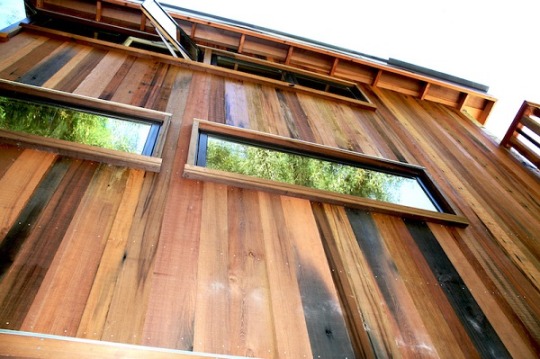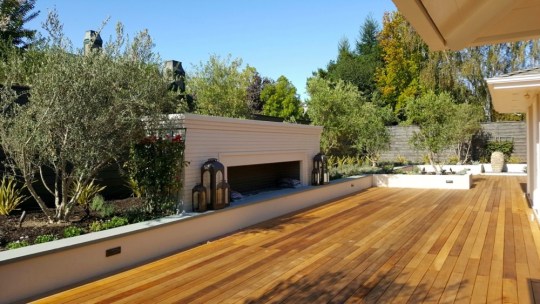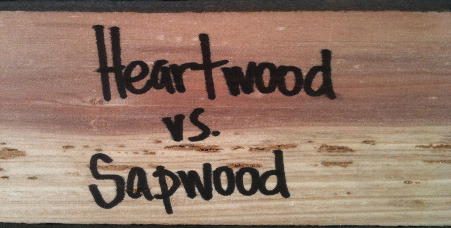Text
Redwood Lumber Grades
The Lumber Baron offers Redwood lumber in 5 distinct grades. Each grade indicates a specific quality or type of wood, and applies to particular traits of the lumber. This includes the color of the wood itself, and the number and size of any knots found in the wood. The grade of the lumber you purchase will affect the cost of the material, what type of construction it is best suited for, and the overall durability of the lumber once it has been installed.
Clear All Heart

Sometimes abbreviated to “CAH” or referred to as “Yellow” because of its yellowish coloring, this is the highest quality of redwood available. This grade has no visible knots, and any minor defects will be limited to the inward face of the material. CAH redwood is perfect for highly visible, external construction.
Clear Heart Fascia
Also called “Red,” or “Fascia,” CHF may contain a small number of knots on the reverse side, but the face will be clear. This grade offers a reddish color, and may exhibit a small amount of edge sapwood. In applications where only the face is visible, this grade is very similar to - and may be mistaken for - the higher CAH grade.
Super Select Heart
Known as “Super,” or even referred to as “Double Green,” this is redwood’s median grade. Material in this category may contain some knots, but none of them may be more than 1-½ inches in diameter. There will be no more than 2 such knots on a piece of lumber measuring 6 inches wide and up to 14 feet in length, and no more than 3 knots in lengths up to 20 feet in length. On pieces 4 inches thick or more, more visible knots may be present, but they must be solid and tight. Edge sapwood may be present, but will not be abundant.
Select Heart
Often called “Select,” and occasionally described as “Single Green,” this grade of redwood may contain edge sapwood on some pieces. It allows for tight knots of up to 2 inches in diameter on pieces up to 6 inches wide, as long as the knots are distributed rather than found in close proximity. Cuts wider than 6 inches may contain more knots or contain more edge sapwood than the 3 higher grades.
Construction Heart
“Con Heart,” or sometimes called “Blue,” is the most economical grade of redwood available from The Lumber Baron. The 6 inch wide section in this category may contain knots up to 2-½ inches in diameter, and the knots may be more closely located than on other grades. Con Heart describes a less precise type of redwood lumber, including loose knots, heart center, and will have more edge sapwood than any of the other grades.
The Lumber Baron offers five different redwood grades, along with a wide variety of reclaimed lumber to meet the needs of your next project. Stop by our lumber yard today to find unique pieces for your next project.
0 notes
Text
Using Reclaimed Lumber in a Green Build
In these environmentally conscious times, green buildings are a popular and stylish way to build. Reclaimed lumber may cost a little more than fresh cuts, but it also has a lot more to offer both the builder and the homeowner. The Lumber Baron is proud to offer both reclaimed redwood and reclaimed Douglas fir, two popular types of lumber which were heavily cut during the early 20th century and used in everything from barns to water tanks.

What is a Green Building?
The definition of a Green building varies from one person to the next, but all definitions include using materials that are both sustainable and durable. Other definitions include alternative power systems, environmental management of the property itself and more. Using reclaimed lumber may be only a single part of a green building, but it is a major step in the right direction.
Benefits of Reclaimed Lumber
From the builder’s perspective, reclaimed lumber provides a denser, stronger type of wood than what is available in fresh cut lumber. The reason for this exceptional building material is that it was milled from all heartwood, the closely packed center of a tree where the wood has been compressed to the point of becoming almost solid. For the homeowner, reclaimed lumber offers a sense of environmental friendliness, plus the satisfaction of using lumber with a quality and texture that was only found in old growth forests of the past.
Building With Americana
Another intriguing aspect of using reclaimed lumber in a green build is that reclaimed lumber has historic value as well as a higher quality. Taken from old bridges, factories and commercial buildings of the early to mid 20th century, each piece has its own story to tell. Often those stories are evident by water marks, milling marks and brands from the original sawmills, and other signs of the how the wood was first used. Reclaimed lumber is a part of the history of our nation’s growth.
Heartwood vs. Sapwood
Heartwood is the central part of a tree. It is usually darker than sapwood, with the growth rings compressed almost to the point of disappearing. Because the heartwood in old growth trees was compressed for untold years, the wood itself became harder and denser as moisture was forced out of the tightly packed heart of the tree. In application, sapwood tends to rot faster than heartwood, and is much more resistant to pests and water damage.
Reclaimed lumber is not generally available from big box hardware stores. Instead, the best selections come from smaller lumber yards such as The Lumber Baron, with representatives who scour the countryside in search of buildings slated for deconstruction. They select only the finest lumber for reuse, and that becomes the reclaimed material used in Green buildings.
0 notes
Text
Reclaimed Hardwood: Natural vs. Freshly Milled
There are a number of differences between freshly milled lumber and reclaimed hardwood. For most applications, reclaimed lumber is a long-lasting, aesthetically pleasing alternative. The fact is, freshly milled lumber may not even offer the same quality when compared to the old growth forests that were used prior to the mid-20th century. Whether your goal is to incorporate a piece of history into your project or produce a visual and textural experience from weathered old growth lumber, reclaimed lumber is an ideal building material.

Environmental Impact
Reclaimed lumber means that no new trees have to be cut down. Reusing old growth lumber also means that you are able to use heartwood, and that is the densest, most appealing part of the tree. Because the oldest, largest trees were cut down years ago, freshly milled lumber is not able to compare in terms of environmental protection. Additionally, reclaimed hardwood may last longer than freshly milled lumber because a lot of today’s new material is cut from sapwood, while a majority of reclaimed lumber was cut from heartwood. This means that reclaimed hardwoods contain less moisture and are more resistant to insect infestation and rot.
Appearance
Reclaimed hardwood has already stood the test of time. Since reclaimed lumber was cut from the heart of trees larger than what is available today, reclaimed lumber allows you to have fewer joins and more consistent grain patterns. Reclaimed lumber has taken on attributes related to it’s previous use. From weather to wine or tobacco, where the wood came from and what it was exposed to have created unique coloration and texture.
Unique Effects
Most freshly milled lumber is nearly identical from one piece to the next. Reclaimed lumber, however, has a history to tell, and it is visible in original nail and bolt holes, Original milling stamps from a time gone by and a density that could only be achieved by decades of natural curing.
The Lumber Baron is proud to be the Bay Area’s premiere source for reclaimed lumber. Our products have been carefully selected to meet stringent quality and appearance points. We invite you to take advantage of our experience in finding and selecting the best materials to turn your next project into something to be remembered. We are open 6 days a week, allowing plenty of time for you to explore our lumber yard and find the best reclaimed lumber for your next project.
0 notes
Text
The Difference Between Heartwood and Sapwood
Heartwood and sapwood are the general method of referring to the types of wood available in a tree trunk. These parts have scientific names as well; “duramen” is used for the heartwood, and “alburnum” for the sapwood. Before you begin building with wood, take a few minutes to familiarize yourself with what the differences between heartwood and sapwood are, and how they affect your project.

The Basic Difference Between Heartwood and Sapwood
Sapwood is the outer part of the trunk, usually lighter in color than the central portion. Nutritional moisture flows through the sapwood, which grows in concentric circles called rings as the tree ages. Heartwood is generally more dense, with closely packed rings. It is composed of drier material that has been compressed over time. The amount of heartwood in a tree is determined by factors such as age, type of tree, and growing conditions. Because they grew for many decades or even centuries, old growth trees contain a higher ratio of heartwood than commercially farmed trees.
Understanding Sapwood
Sapwood can be thought of as the flesh and veins of the tree. As the name implies, the sapwood is where the the circulation of the living tree occurs. The fibers are not as densely packed, which allows nutrient-carrying moisture to move through the tree between the roots, branches, and leaves. Sapwood tends to contain much more moisture, and because it is not as densely packed it is also susceptible to shrinkage as the cut lumber cures.
Heartwood Specifics
The interior portion, or heartwood, is compressed through time, pressing the growth rings closer together and squeezing out the moisture. If sapwood is the flesh of the tree, then heartwood is the supporting skeleton which allows the tree to stand upright. As an example, a young tree tends to be more limber in heavy winds, while older trees, because they have more heartwood, hardly react to heavy winds at all. Heartwood is often referred to as being dead, but it is actually much more densely packed, leaving little room for moisture.
Choosing Between Heartwood and Sapwood
When strength is a major concern, heartwood is preferable to sapwood. It is also naturally “cured on the tree,” altering the coloration and durability of the finished lumber. Sapwood is more suitable for projects that demand speed or ease of use. Wall studs tend to be made from sapwood because it is easier to drive fasteners through and cuts easily. Stairs, mantle pieces, and large wood projects such as beams are better suited for heartwood. For aesthetic appeal, heartwood is usually a better choice.
The Lumber Baron carries a unique selection of heartwood, including a wide assortment of reclaimed redwood and other lumber with unique properties of its own. Whether you are framing a home or designing a one-of-a-kind countertop, our selection of lumber will fit your needs. And unlike the big box stores, we are also a lumber mill, capable of surfacing or milling your material to meet custom sizes and appearances. Visit us today and let us assist you in finding the best lumber for your next project.
0 notes